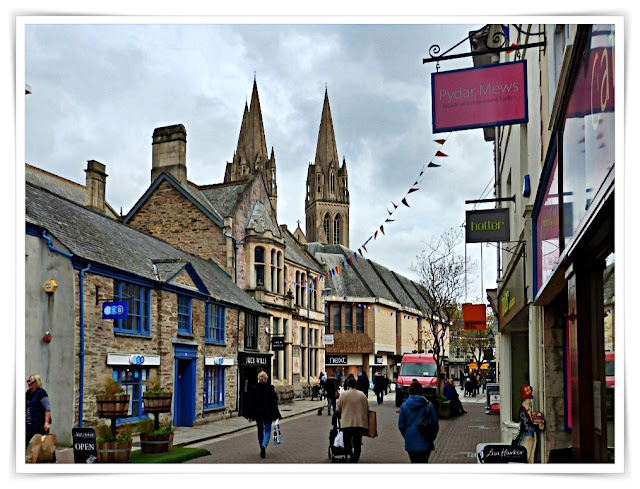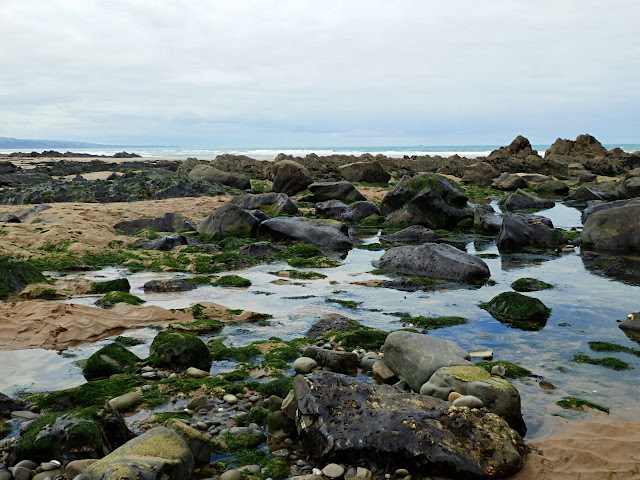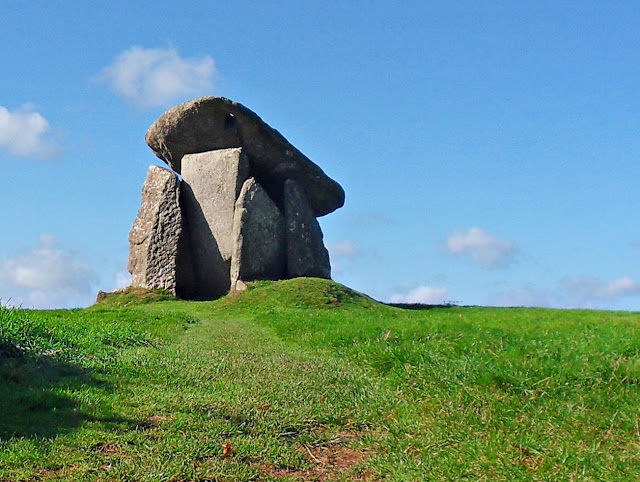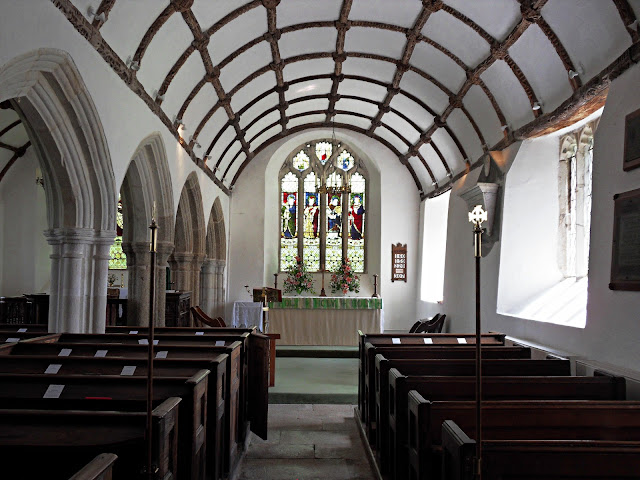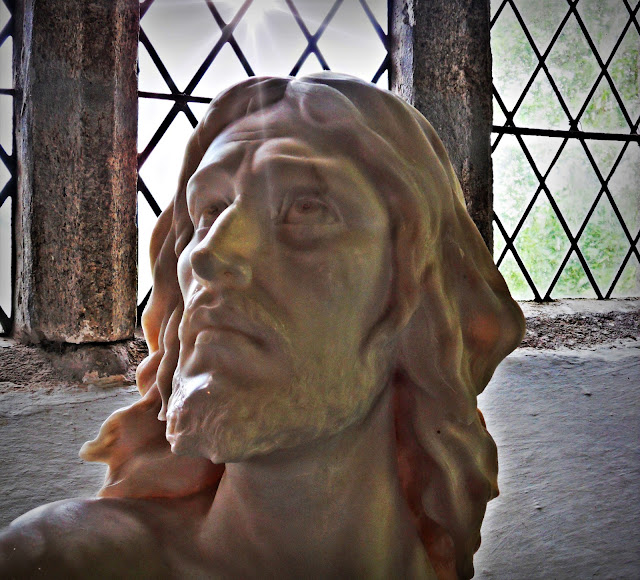My wife had an appointment in Truro, Cornwall's cathedral city, so I had about one and a half hours to fill. I decided to wander round the city and then make my way to Victoria Gardens to see if there were any flower displays. I started out at the Cathedral - some lovely carvings at the front of the building - as above.
I often visit Truro but it struck me how the cathedral dominates everything - wherever you look - there's the cathedral looking down from on high.
Walk further and the cathedral is still there. It even seems to squeeze between the narrow lanes ...
... glance sideways and there's a spire - or three.
I made my way out of the shopping area and passed the Cornwall's Courts of Justice on my way to Victoria Gardens.
But looking back from the court what do we still see? Why, the cathedral, of course.
There is a gate by the court that leads to Victoria Gardens. There are so many lovely mature trees.
The garden was created to commemorate Queen Victoria's Diamond Jubilee - so that would have been in June of 1897.
A much newer contribution to the gardens is the Invictus Vase of Hope - as above. And I found some flowers too.
The bandstand is a prominent feature. During the May to September period there are often free concerts - a relaxing way to spend an afternoon.
As I wandered I snapped a few photos of the flowers.
Love the subtle colours ...
... and also the matching colour by the small lake.
As time was getting on I meandered my way back to the main city.
Not everything is old in Truro. There are a few modern stores, of well known retail names like Primark, Marks & Spencer and so on.
Then a phone call from my wife, would I meet her ... by the entrance to the cathedral ... of course, where else!
Tuesday 14 May 2019
Sunday 12 May 2019
A Wonderful Display of Rocks, Cliffs, Pebbles and Sand at Northcott Mouth, Cornwall
Northcott Mouth, on Cornwall's north coast, is described as a rocky beach with expansive sand and rock pools as the tide drops. What fascinated me though were the wonderful rocks - the colours, the shapes and so on.
We'd never been to Northcott Mouth previously and spent an age just looking at the cliffs, rock pools and rocks generally. It was lovely as we were the only people on the beach. The dullness of the day must have put people off walking.
I'll let the photos tell there own story.

|
Friday 10 May 2019
Miles of Beach at Widemouth Bay, Cornwall for Surfers and Holiday Makers
We were visiting the north coast of Cornwall and had arranged a weeks stay in a small cottage in the village of Poughill. We left home quite early and took the coast route so we could stop several times on the way.
One of our stops was at Widemouth Bay, which is about three or four miles from the town of Bude. As can be seen by the photo above, the weather looked non too clever, but we managed a blustery walk along the cliffs.
After a while the weather took pity on us and the sky changed to blue.
The air gradually became warmer. It was then easier to see why this two mile long beach is so popular, in the summer months, with holiday makers, surfers and beachcombers.
Widemouth Bay is on the Atlantic coast and can get the full blast of the westerly winds - but this is good for surfing. The RNLI lifeguards have a station on the beach - just in case of any problems.
There are surfing schools on the beach for the inexperienced.
We had hoped to return to Widemouth Bay, during our break, but found many other walks and interesting places, so never got round to making another visit.
Wednesday 8 May 2019
The Lost Gardens of Heligan: 18 Photos of Farm Animals, Plants and Jungle
Towards the end of April we visited The Lost Gardens of Heligan, Cornwall. As I have said before, it's somewhere we visit throughout the year, whatever the season.
One of the main features of this visit though wasn't only the gardens. It was the new born farm animals as well.
The mother pig is Actress a British Lop Gilt - which is an endangered species. There are less than 160 breeding sows remaining in population.
As well as piglets there were also lambs.
One of the lambs was particularly inquisitive and couldn't wait to get his picture taken.
The family in the barn wanted a more formal photo, which included the newly born lamb.
Not sure what these chicks had done wrong to warrant a prison sentence, but they seemed happy enough. I don't like to see animals and birds behind bars.
But time to move on to the gardens.
Blossom on the archway of apple trees.
A quick peek into the Potting Shed.
There is certainly an array of old tools - but I wasn't in a working mode, so left them behind.
The house at Heligan is private, but is an impressive building.
Flowers of forget-me-not in the Sundial garden ...
... but we decided to head for the jungle ...
... passing the bamboo ...
... and onto the wooden walkway.
Quite a selection of trees in the valley, some of the them are hundreds of years old.
There are gunnera and tree ferns galore.
Finally we left the jungle and made our way into the more formal gardens before heading home - after another quick look at the animals.
Other Lost Gardens of Heligan Posts:
Thirteen February Photos of the Lost Gardens of Heligan
Lost Gardens of Heligan in Winter
Monday 6 May 2019
Over 5000 Years Old: The Mysterious Trevethy Quoit In Cornwall
Monuments like the Trevethy Quoit raise so many questions. They are quite mind blowing as some 'experts' say that were constructed around 3500 BC. But there again, I read one report where the conclusion was that they could be from 6000 BC - not sure of that, but they must be at least 5000 years old - so they are on a par with the much more famous Stonehenge.
Then there is question as to how the people, of that time, moved the seven stones that make up the quoit. The capstone is reckoned to weigh something like 10.5 tons.
And so the questions go on. If we look at the photo below it can be seen that there is a hole in the capstone. Why?
Again opinions are split. The hole could perhaps be for astrological reasons. Maybe the hole was added later. It is said that in the 1600s the local people used this to hold a flagpole.
Okay lets look at some of the possibilities as to the purpose of the Quoit.
(a) To hold the bones of the dead.
(b) To mark communal territory.
(c) As a gathering place.
(d) For ritual and ceremonial life for the local community.
All well and good but lets have a closer look at different parts of the Trevethy Quoit. The photos above are all from the east side of the monument.
In the photo below it can be seen that at the bottom of the large upright stone, to the right hand side, there is an opening which may have been used as access to the inner part of the quoit.
The next photo shows the south side of the monument. As can be seen the large stone to the west side, in shadow, has unfortunately, collapsed. This seemingly happened in 1850.
Looking at the western collapsed stone it can be seen that there are several small holes or indentations in the stone. There is a story as to what these are. They are Midsummer Merriment Holes.
The story is that a young man, of the middle ages, would have filled such a hole with a small explosive. He would then have lit this to proclaim his love for a sweetheart - ahhhh!
Going back to the Trevethy Quoit, as a whole, it is is mostly thought that this was a burial chamber, It would have been partly covered with soil and stones so, from a distance, it would appear to be a natural mound in the landscape. It isn't believed though that it would have been completely covered.
If the monument was erected around 3500BC this would be during the Neolithic period. At this time there were known to be people living in the area. It was a time when there would have been some of the first farmers. In fact the Parish of St Cleer, which encompasses Trevethy Quoit, is believed to have been inhabited from 6000 BC.
Of course there are still many unanswered questions about this and other such quoits. To finish though here are a few random photos of the monument.
I wonder what you think their purpose was, when they were built all of those thousands of years ago.
Similar Posts:
(1) The Mysterious Roche Rock, Cornwall
(2) The Mystery of the Three Hurlers Stone Circles on Bodmin Moor
(3) The Ancient Stone, Over 1100 Years Old, known as Doniert's Stone
Saturday 4 May 2019
St.Sampson's Church and Holy Well On the Saints' Way At Golant, Cornwall
While out walking we passed St.Sampson's Church at Golant and its Holy Well. A hermit's hut, chapel and church has stood on this plot for at least 1500 years.
The church lies on the Saints' Way along which many Celtic saints walked from Padstow to Fowey - thus avoiding the perilous sea route around Lands End - on their way to preach God's word to Europe. St. Sampson was one of those who undertook this journey.
Inside the church the roof has ornate wooden, carved bosses (above). It's a very welcoming place, open to all, and has a good vibe. It's obviously a much loved church.
The shape of the church is typically 13th or 14th century with an aisle divided from the nave by an arcade of seven arches. Some claim that this shows a Portuguese or Spanish influence. This is not so surprising as there was much trade between nearby Fowey with Spain and Portugal. One merchant, Frissart de Bragga, even became Admiral of the Port of Fowey in 1347.
The head of Jesus was given to the church by Rev. J.L. Lyne who became Father Ignatius of Llanthony - he preached his very first sermon in the church.
The Holy Well can be found at the left side of the entrance porch, The water is used for baptisms and the like.
There is a metal gate in front of the Holy Well but this is easily opened - so I could splash some water on my face!
Subscribe to:
Posts (Atom)
FEATURED POST
A Walk to Pentewan Village, Beach and Harbour
It was a sunshine day so we decided on a walk to Pentewan along the Pentewan Trail starting from the bridge as shown above. ...



